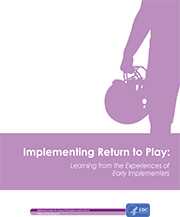Sports Concussion Policies and Laws
Information for Parents, Coaches, and School & Sports Professionals
Get a HEADS UP on Concussion in Sports Policies

Recently many states, schools, and sports leagues and organizations have created policies or action plans on concussion in youth and high school sports. While these policy efforts show some promise, more research is needed to learn if these strategies can help educate coaches and parents about this issue and help protect children and teens from concussion and other serious brain injuries.
Implementing Return to Play: Learning from the Experiences of Early Implementers

In May 2009, the State of Washington passed the “Zackery Lystedt Law” to address concussion management in youth athletics. The Washington law was the first state law to require a “removal and clearance for Return to Play” among youth athletes. Now all 50 states have a Return to Play law.
In order to assess the implementation of Return to Play laws, the National Center for Injury Prevention and Control (NCIPC) conducted a case study evaluation on the Return to Play implementation efforts in two states: Washington and Massachusetts. These two states were selected because they were both early adopters of Return to Play and because their laws varied on several important dimensions, including the role of the health department and other stakeholder groups. The evaluation was designed to assess implementation efforts, including related challenges and successes in implementation.
Return to Play laws include a variety of different components that can be complicated to implement, such as removal from play, collection of concussion histories, required training for different stakeholders, etc. Additionally, Return to Play laws do not always provide specific guidance on how each of the components of the laws should be carried out. Some laws identify a specific entity, such as a state agency, to develop regulations and other laws are less specific. As a result, implementers are sometimes required to make decisions after the law has passed that can have an impact on successful implementation. Thoroughly considering the logistics of implementation and engaging in a robust planning process can help increase the consistency and quality of implementation.
Based on the experiences of the stakeholders interviewed in Massachusetts and Washington, there are a number of key considerations for the implementation of Return to Play. The guide presents considerations, as well as lessons learned from state stakeholders and potential barriers to implementation, in the following areas:
- Stakeholder Roles and Responsibilities
- Implementation Requirements
- Knowledge and Awareness
- Medical Clearance
- Supporting and Monitoring Implementation
- Planning Ahead to Evaluate the Impact of Return to Play
- Page last reviewed: February 16, 2015
- Page last updated: February 16, 2015
- Content source:
- Centers for Disease Control and Prevention,
- National Center for Injury Prevention and Control,
- Division of Unintentional Injury Prevention


 ShareCompartir
ShareCompartir